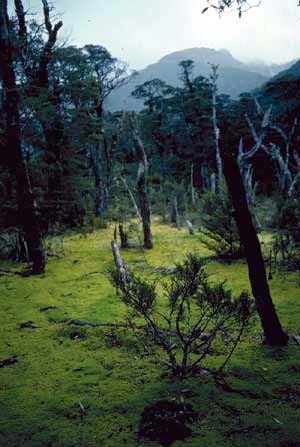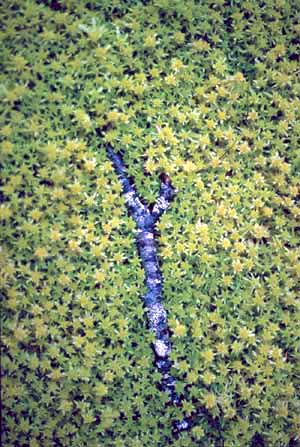Sphagnum and Water
Super Moss
Sphagnum plants can hold more than 20 times their own weight in water. The Australian species of Sphagnum are found predominantly in extensive colonies in alpine or sub-alpine bogs; smaller areas of Sphagnum can be found at much lower altitudes, in places almost down to sea level. Sphagnum absorbs a vast quantity of water during any heavy downpour or after snowmelt and then releases much of that water in a more gradual flow over a much longer period.
The water in sphagnum bogs is acidic, nutrient-poor and with a low oxygen content, creating conditions that many organisms cannot tolerate. In particular, decay bacteria cannot survive so organic matter may be quite well preserved in sphagnum bogs. In Europe such bogs have yielded well-preserved human bodies thousands of years old.
 A view of an alpine sphagnum bog ... |
 and a closer view of Sphagnum plants. |
Sphagnum provides habitats for many plants and animals that have adapted to the specialised conditions. Various prickly-leaved heath shrubs in the Epacridaceae family are common in sphagnum bogs in Australia. Additionally, various sedges, grasses and daisy flowers help provide a rich plant community that supports a wide variety of animal life.
 A Northern Corroboree Frog, Pseudophryne pengilleyi, on a bed of Sphagnum. |
Amongst the vertebrate inhabitants are two very striking frogs, the Southern Corroboree Frog, Pseudophryne corroboree, and the Northern Corroboree Frog, Pseudophryne pengilleyi. These endangered frogs breed in sphagnum bogs in the alpine and sub-alpine areas of NSW and the ACT but move away from boggy areas outside of the breeding season.
Sphagnum and Gardening
All species of Sphagnum are protected in Australia and collection from the wild without a permit is illegal. Most sphagnum sold for gardening use is imported, although a small amout is harvested legally in Tasmania. The most environmentally friendly substitute for sphagnum moss and peat is coir dust, a byproduct of the coconut industry. This renewable resource has many of the same properties that make sphagnum moss and peat popular with gardeners. Ask at your local gardening centre about this and other environmentally sustainable materials for potting mixes.
Mosses at WarSphagnum was used extensively as a surgical dressing during the First World War. A writer in 1917 pointed out that Sphagnum pads were superior to cotton because they:
Just think — much of the cotton that could have been used for dressings was used to make gun-cotton, which was used in making munitions, which wounded people, who then needed surgical dressings — which could not be made from cotton because that had been used for gun-cotton! |
![An Australian Government Initiative [logo]](/images/austgovt_brown_90px.gif)

